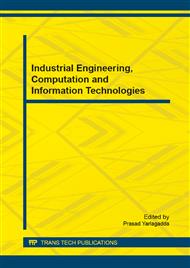[1]
P. N. Belhumeur, J. P. Hespanha and D. J. Kriegman, Eigenfaces vs. Fisherfaces: recognition using class specific linear projection, IEEE transactions on pattern analysis and machine intelligence, 1997, 19(7): 711-720.
DOI: 10.1109/34.598228
Google Scholar
[2]
L. Chen, H. Liao, M. Ko, J. Lin, and G. Yu, A new LDA-based face recognition system which can solve the small sample size problem, Pattern Recognition, 2000, 33(10): 1713–1726.
DOI: 10.1016/s0031-3203(99)00139-9
Google Scholar
[3]
D. Q. Dai and P. C. Yuen, Regularized discriminant analysis and its application to face recognition, Pattern Recognition, 2003, 36( 3): 845–847.
DOI: 10.1016/s0031-3203(02)00092-4
Google Scholar
[4]
I. Pima, M. Aladjem, Regularizedd is criminant analysis for face recognition, Pattern Recognition, 2004, 37( 9): 1945-(1948).
DOI: 10.1016/j.patcog.2004.03.011
Google Scholar
[5]
D. Q. Dai and P. C. Yuen, Face recognition by regularized discriminant analysis, IEEE Transactions on System, Man and Cybernetics-part B: Cybernetics, 37(4): 1080–1085.
DOI: 10.1109/tsmcb.2007.895363
Google Scholar
[6]
H. Li, T. Jiang and K. Zhang, Efficient and robust feature extraction by maximum margin criterion, IEEE transactions on neural networks, 2006, 17(1): 157-165.
DOI: 10.1109/tnn.2005.860852
Google Scholar
[7]
H. Cevikalp, M. Neamtu, M. Wilkes, A. Barkana, Discriminative common vectors for face recognition, IEEE Transactions on pattern analysis and machine intelligence . 2005, 27 (1): 4–13.
DOI: 10.1109/tpami.2005.9
Google Scholar
[8]
Li, M., Yuan, B., 2D-LDA: A statistical linear discriminant analysis for image matrix, Pattern Recognition Letters. 2005, 26 (5), 527–532.
DOI: 10.1016/j.patrec.2004.09.007
Google Scholar
[9]
W. Yu, Two-dimensional discriminant locality preserving projections for face recognition, Pattern Recognition Letters, 2009, 30(15): 1378-1383.
DOI: 10.1016/j.patrec.2009.07.004
Google Scholar
[10]
R. Zhi ,Q. Ruan, Two-dimensional direct and weighted linear discriminant analysis for face recognition, 2008, 71(16-18): 3607-3611.
DOI: 10.1016/j.neucom.2008.04.047
Google Scholar
[11]
R. P. W. Uuin and R. Haeb-Umbach, Multiclass linear dimension reduction by weighted pairwise fisher criteria, IEEE transactions on pattern analysis and machine intelligence, 2001, 23(7): 762-766.
DOI: 10.1109/34.935849
Google Scholar
[12]
Yang J., Zhang D., Frangi A.F., Yang J., Two dimensional PCA: A new approach to to appearance-based face representation and recognition , IEEE transactions on pattern analysis and machine intelligence, 2004, 26(1): 131-137.
DOI: 10.1109/tpami.2004.1261097
Google Scholar


